
|
|
| 1950th | 1960th | 1970th | 1980th | 1990th | Links |
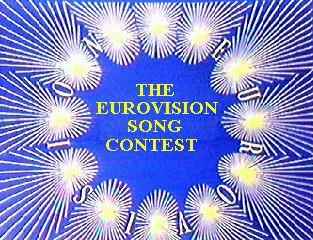 In
the mid-1950s the members of the European Broadcasting Union set up an ad hoc committee to
investigate ways of rallying the countries of Europe round a light entertainment
programme. At Monaco in late January 1955 this committee, chaired by Marcel Bezençon,
Director General of Swiss Television, came up with the idea of creating a song contest,
inspired by the very popular San Remo Festival. The idea was approved by the EBU General
Assembly i n Rome on 19 October 1955 and it was decided that the first “Eurovision Grand
Prix” – so baptized, incidentally, by a British journalist – would take place in
spring 1956 at Lugano, Switzerland. In
the mid-1950s the members of the European Broadcasting Union set up an ad hoc committee to
investigate ways of rallying the countries of Europe round a light entertainment
programme. At Monaco in late January 1955 this committee, chaired by Marcel Bezençon,
Director General of Swiss Television, came up with the idea of creating a song contest,
inspired by the very popular San Remo Festival. The idea was approved by the EBU General
Assembly i n Rome on 19 October 1955 and it was decided that the first “Eurovision Grand
Prix” – so baptized, incidentally, by a British journalist – would take place in
spring 1956 at Lugano, Switzerland. |
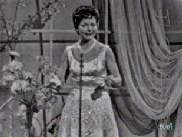 The next step was to put together a set of rules to be
followed by the participants, of which there were originally ten, although only seven
countries were eventually allowed to take part: Belgium, France, Italy, Luxembourg, the
Netherlands, Switzerland and West Germany. The other three countries – Austria, Denmark
and United Kingdom – registered after the official deadline and were thus disqualified
from entering the contest. The next step was to put together a set of rules to be
followed by the participants, of which there were originally ten, although only seven
countries were eventually allowed to take part: Belgium, France, Italy, Luxembourg, the
Netherlands, Switzerland and West Germany. The other three countries – Austria, Denmark
and United Kingdom – registered after the official deadline and were thus disqualified
from entering the contest. The rules of the first contest allowed the participants to enter a maximum of two songs each, and it was strongly recommended that the songs be selected at a national final involving the participation of the public, to render the contest as popular as possible. There was no rule on language, each participant being entitled to choose the language in which they wished to perform. There was, however, a rule on the amount of time allowed: three and a half minutes was the maximum for each performance. Nor was there any restriction on the number of artists on stage, and each country could use its own conductor if it so chose. The order of appearance was decided by drawing lots, but the participants could choose which of their two songs they wanted to perform first. The jury was made up of two delegates from each participating country, among whom one president and two scrutineers were appointed by secret ballot of the members to collect the votes and draw up the final rankings of the songs at the end of the performances. The jury was to judge the contest from a small television screen and each jury member awarded a mark for each song, ranging from 1 to 10 in ascending order of merit, on a paper provided for the purpose. The song obtaining the most points was awarded the “1956 Grand Prix of the Eurovision Song Contest”. At that time there was no rule against members of the jury voting for their own country, and no material awards were attached to the contest. As for the financing of the contest, participants paid their own expenses and the host country (Switzerland that year) bore the whole cost of organizing the European final. The winner of the Grand Prix was Switzerland with the song “Refrain”, performed by Lys Assia. |
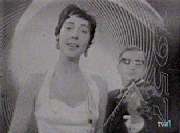 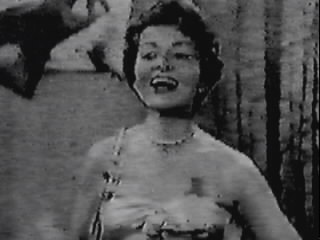 Another contest was organized in 1957 on the
strength of the instant success achieved by the “Eurovision Grand Prix”, but this time
the host country was West Germany. In comparison to 1956, several rules were changed. Another contest was organized in 1957 on the
strength of the instant success achieved by the “Eurovision Grand Prix”, but this time
the host country was West Germany. In comparison to 1956, several rules were changed.First of all, this time all ten countries participated in the final, each country could only perform one song, to be rendered by one or at most two singers, and no vocal accompaniment was allowed. The jury was composed of 10 members from each country who announced their votes by telephone after the last entry. These ten members were allowed to award only one vote to their preferred song and no jury member was allowed to vote for his/her own country’s song. Furthermore, the jury members could only watch the voting after they had cast their own votes. The scoreboard was introduced for the first time. That year the Grand Prix was awarded to the Netherlands with the song “Net als toen” performed by Corrie Brokken, and the tradition of prizes was introduced. The celebrated artist Lys Assia, who had won the first Eurovision Grand Prix, was placed 7th with the song “L’enfant que j’étais”, representing Switzerland. |
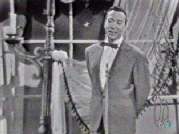 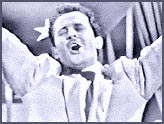 By 1958, the “Eurovision Grand Prix” had
become an annual event, and the tradition whereby the winning country hosts the following
year’s contest was introduced. That year the United Kingdom did not participate in the
contest, and this allowed Sweden to make its debut. Incidentally, some of the songs
performed became popular hits within their countries and made the charts in others, such
as the French entry “Dors mon amour” performed by André Claveau, winner of the Grand
Prix and Italy's entry "Nel blu dipinto blu" (Volare) performed by Domenico
Modungno who probably became the most successful song of all time placed 3rd. Lys Assia
returned for the third time representing Switzerland and was placed 2nd with the song
“Giorgio”. By 1958, the “Eurovision Grand Prix” had
become an annual event, and the tradition whereby the winning country hosts the following
year’s contest was introduced. That year the United Kingdom did not participate in the
contest, and this allowed Sweden to make its debut. Incidentally, some of the songs
performed became popular hits within their countries and made the charts in others, such
as the French entry “Dors mon amour” performed by André Claveau, winner of the Grand
Prix and Italy's entry "Nel blu dipinto blu" (Volare) performed by Domenico
Modungno who probably became the most successful song of all time placed 3rd. Lys Assia
returned for the third time representing Switzerland and was placed 2nd with the song
“Giorgio”. |
 In 1959, Luxembourg withdrew from the contest,
the United Kingdom returned and Monaco made its debut, thus increasing the number of
participating countries to eleven. Only one rule changed that year, to ensure that no
professional composers or publishers were allowed to sit on the juries. The Netherlands
were awarded the Grand Prix for the second time with the song “Een beetje”, performed
by Teddy Scholten. In 1959, Luxembourg withdrew from the contest,
the United Kingdom returned and Monaco made its debut, thus increasing the number of
participating countries to eleven. Only one rule changed that year, to ensure that no
professional composers or publishers were allowed to sit on the juries. The Netherlands
were awarded the Grand Prix for the second time with the song “Een beetje”, performed
by Teddy Scholten. |
| 1950th | 1960th | 1970th | 1980th | 1990th | Links |